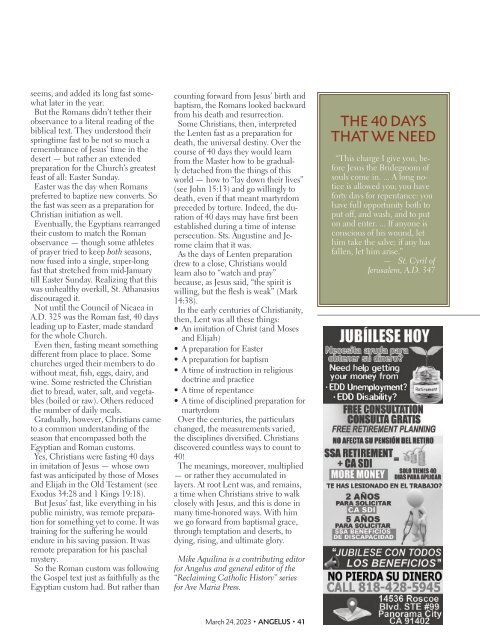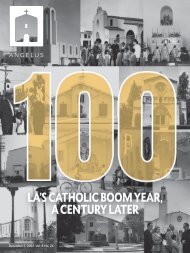Angelus News | March 24, 2023 | Vol. 8 No. 6
On the cover: Bishop David G. O’Connell of Los Angeles at his installation Mass as auxiliary bishop at the Chapel of the Annunciation in San Gabriel in November 2015. In this special issue of Angelus, we pay tribute to a beloved bishop and courageous missionary who won hearts and souls for Jesus Christ wherever he went. Our team coverage begins on Page 10 with a chronicle of LA’s three-day farewell to its beloved ‘Bishop Dave,’ and later, on Page 16, stories and perspectives from his closest loved ones about his vocation and ties to his homeland.
On the cover: Bishop David G. O’Connell of Los Angeles at his installation Mass as auxiliary bishop at the Chapel of the Annunciation in San Gabriel in November 2015. In this special issue of Angelus, we pay tribute to a beloved bishop and courageous missionary who won hearts and souls for Jesus Christ wherever he went. Our team coverage begins on Page 10 with a chronicle of LA’s three-day farewell to its beloved ‘Bishop Dave,’ and later, on Page 16, stories and perspectives from his closest loved ones about his vocation and ties to his homeland.
Create successful ePaper yourself
Turn your PDF publications into a flip-book with our unique Google optimized e-Paper software.
seems, and added its long fast somewhat<br />
later in the year.<br />
But the Romans didn’t tether their<br />
observance to a literal reading of the<br />
biblical text. They understood their<br />
springtime fast to be not so much a<br />
remembrance of Jesus’ time in the<br />
desert — but rather an extended<br />
preparation for the Church’s greatest<br />
feast of all: Easter Sunday.<br />
Easter was the day when Romans<br />
preferred to baptize new converts. So<br />
the fast was seen as a preparation for<br />
Christian initiation as well.<br />
Eventually, the Egyptians rearranged<br />
their custom to match the Roman<br />
observance — though some athletes<br />
of prayer tried to keep both seasons,<br />
now fused into a single, super-long<br />
fast that stretched from mid-January<br />
till Easter Sunday. Realizing that this<br />
was unhealthy overkill, St. Athanasius<br />
discouraged it.<br />
<strong>No</strong>t until the Council of Nicaea in<br />
A.D. 325 was the Roman fast, 40 days<br />
leading up to Easter, made standard<br />
for the whole Church.<br />
Even then, fasting meant something<br />
different from place to place. Some<br />
churches urged their members to do<br />
without meat, fish, eggs, dairy, and<br />
wine. Some restricted the Christian<br />
diet to bread, water, salt, and vegetables<br />
(boiled or raw). Others reduced<br />
the number of daily meals.<br />
Gradually, however, Christians came<br />
to a common understanding of the<br />
season that encompassed both the<br />
Egyptian and Roman customs.<br />
Yes, Christians were fasting 40 days<br />
in imitation of Jesus — whose own<br />
fast was anticipated by those of Moses<br />
and Elijah in the Old Testament (see<br />
Exodus 34:28 and 1 Kings 19:18).<br />
But Jesus’ fast, like everything in his<br />
public ministry, was remote preparation<br />
for something yet to come. It was<br />
training for the suffering he would<br />
endure in his saving passion. It was<br />
remote preparation for his paschal<br />
mystery.<br />
So the Roman custom was following<br />
the Gospel text just as faithfully as the<br />
Egyptian custom had. But rather than<br />
counting forward from Jesus’ birth and<br />
baptism, the Romans looked backward<br />
from his death and resurrection.<br />
Some Christians, then, interpreted<br />
the Lenten fast as a preparation for<br />
death, the universal destiny. Over the<br />
course of 40 days they would learn<br />
from the Master how to be gradually<br />
detached from the things of this<br />
world — how to “lay down their lives”<br />
(see John 15:13) and go willingly to<br />
death, even if that meant martyrdom<br />
preceded by torture. Indeed, the duration<br />
of 40 days may have first been<br />
established during a time of intense<br />
persecution. Sts. Augustine and Jerome<br />
claim that it was.<br />
As the days of Lenten preparation<br />
drew to a close, Christians would<br />
learn also to “watch and pray”<br />
because, as Jesus said, “the spirit is<br />
willing, but the flesh is weak” (Mark<br />
14:38).<br />
In the early centuries of Christianity,<br />
then, Lent was all these things:<br />
• An imitation of Christ (and Moses<br />
and Elijah)<br />
• A preparation for Easter<br />
• A preparation for baptism<br />
• A time of instruction in religious<br />
doctrine and practice<br />
• A time of repentance<br />
• A time of disciplined preparation for<br />
martyrdom<br />
Over the centuries, the particulars<br />
changed, the measurements varied,<br />
the disciplines diversified. Christians<br />
discovered countless ways to count to<br />
40!<br />
The meanings, moreover, multiplied<br />
— or rather they accumulated in<br />
layers. At root Lent was, and remains,<br />
a time when Christians strive to walk<br />
closely with Jesus, and this is done in<br />
many time-honored ways. With him<br />
we go forward from baptismal grace,<br />
through temptation and deserts, to<br />
dying, rising, and ultimate glory.<br />
Mike Aquilina is a contributing editor<br />
for <strong>Angelus</strong> and general editor of the<br />
“Reclaiming Catholic History” series<br />
for Ave Maria Press.<br />
THE 40 DAYS<br />
THAT WE NEED<br />
“This charge I give you, before<br />
Jesus the Bridegroom of<br />
souls come in. ... A long notice<br />
is allowed you; you have<br />
forty days for repentance: you<br />
have full opportunity both to<br />
put off, and wash, and to put<br />
on and enter. ... If anyone is<br />
conscious of his wound, let<br />
him take the salve; if any has<br />
fallen, let him arise.”<br />
— St. Cyril of<br />
Jerusalem, A.D. 347<br />
<strong>March</strong> <strong>24</strong>, <strong>2023</strong> • ANGELUS • 41


















